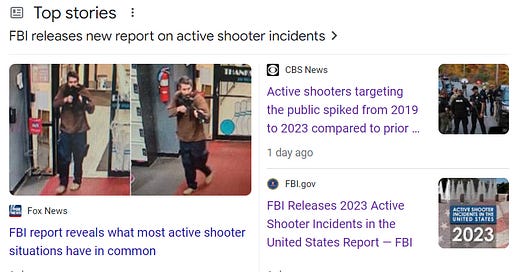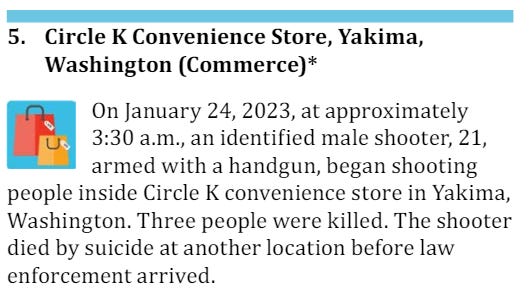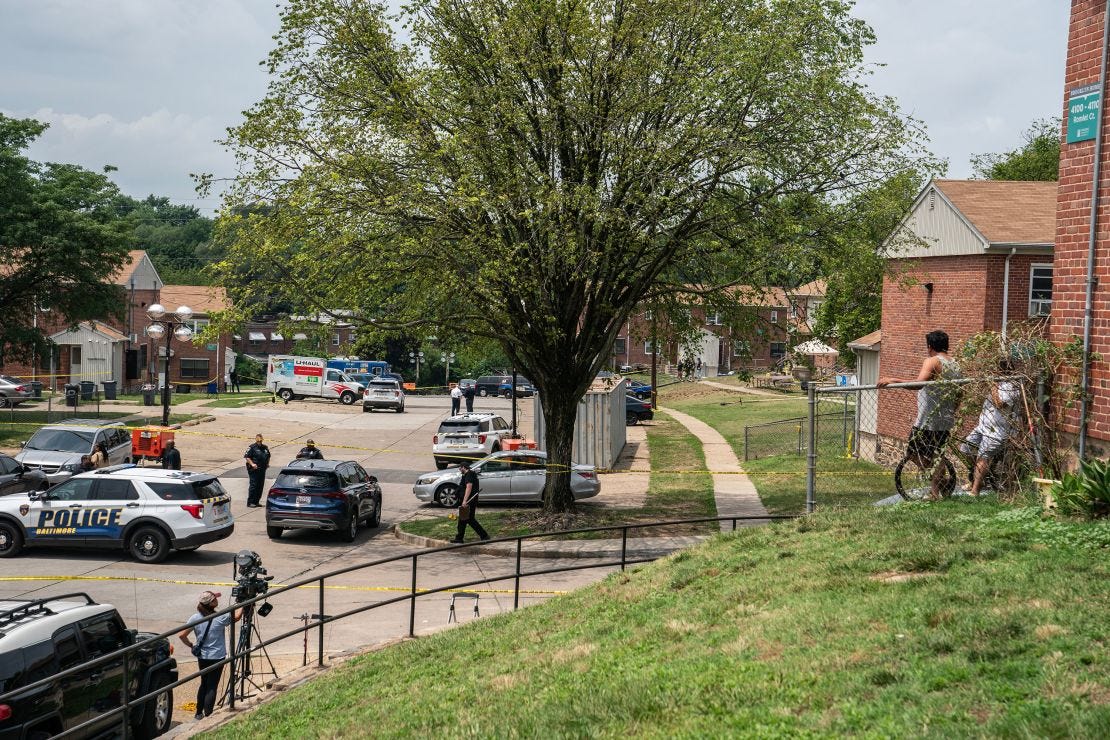What's really in the FBI report about 'active shooters' in 2023?
The 48 'active shooters' the FBI analyzed include a man who fired shots that missed cars on a highway, a shooting in the front yard of a house, and 3 people shot inside a Circle K at 3:30am.
On Monday the FBI released a report on the characteristics of ‘active shooter’ attacks in 2023. The report quickly made headlines across national news outlets.
When the average citizen hears ‘active shooter’, we think about the photos in the top stories like a man with a rifle walking into a bowling alley.
Beyond the headlines and executive summary, what did this report analyze and how does this fit into solving the public health crisis of gun violence in America (see: U.S. surgeon general declares gun violence a public health crisis).
What is an ‘active shooter’?
For this report the FBI defines an active shooter as one or more individuals actively engaged in killing or attempting to kill people in a populated area.
Where this gets tricky is a broad list of subjective criteria that disqualify an incident:
Self-defense
Gang violence
Drug-related violence
Residential or domestic disputes
Barricade/hostage situations
Shootings where the shooter’s actions were the result of another criminal act
Crossfire as a byproduct of another ongoing criminal act
An action that appeared not to have put other people in peril
These exclusion criteria make deciding if something is an ‘active shooter’ a biased rather than scientific question.
For example, if 100 people are gathered in a park and someone opens fire wounding 30 random adults, teens, and kids, is this not an active shooter if one person was smoking marijuana or wearing a red bandana associated with a gang? Rather than objective criteria, the FBI agents (or more likely highly paid contractors) writing this report get to decide what they personally want to include or exclude.
Inconsistency and losing the spirit of the issue
The average citizen cares about random gunfire in public places because this could be you and your family becoming the next victims of a mass shooting.
In this report, many shootings that most people would really care about are excluded, while a bunch of strangely random and isolated shootings are included.
Note: the whole reason I created the K-12 School Shooting Database was to capture data on every shooting on school property. I know all about random and isolated incidents. Picking out 48 random incidents from thousands of shootings nationwide makes no sense. You either need to include everything, or a very specific subset with transparent and reproducible criteria. This FBI report is neither.
This definition and subjective criteria problems are compounded because the incidents included in this report have the same “weight” meaning they all look the same in the summary charts. If I was writing this report, the shootings with dozens of victims would get extra weight such as:
Star Ballroom Dance Studio in Monterey Park, CA with 20 victims shot
17 people shot at an outlet mall by a man with a rifle in Allen, TX
31 people shot at a bowling alley and grill in Lewiston, ME
Thirteen people shot at Old National Bank in Louisville, KY
Instead, these deliberate attacks look the same on a bar graph or map as the incidents with 1 person shot by a perpetrator who fled and was arrested the next day.
The way the FBI presents this information makes these 48 shootings all look the same when they are very different. On top of that, some of these shootings aren’t what you would think of when you hear ‘active shooter’.
Dozens of innocent bystanders shot at block parties, graduation parties, and community gatherings are excluded for this report. A drive-by shootings with specific targets—despite dozens of random and innocent bystanders becoming the victims—is also excluded. Yet someone firing randomly from a vehicle without anyone injured is included by the FBI as an ‘active shooter’.
Does this make any sense to you? It doesn’t to me and reading about these cases in the report highlights the methodological problem with the FBI report.
What’s in the report?
Here are a few examples of incidents labeled as ‘active shooters’ by the FBI in the 2023 totals:
January 5: A man driving around Pittsburgh fired shots wounding two people (one was injured by broken glass not a bullet). The shooter fled and was arrested away from the crime scene.
January 12: A man shot three people in Seattle, fled, and was arrested away from the crime scene.
January 24: Three people were shot at 3:30am at a Circle K convenience store in Yakima, WA. The shooter killed himself before police arrived.
March 22: A man fired shots in a rural area outside of Baton Rouge, LA. One person was wounded and he fled before police arrived.
March 27: A man fired shots at vehicles on a public street. Nobody was injured and he was killed by police at a different location away from the crime scene.
April 20: A man fired shots on a public street, one person was wounded, he fled from the scene, and was arrested later by police.
April 25: A man shot two people at a skate park, fled from the crime scene, and was arrested at a different location.
July 23: At 2:30am a man fired shots at vehicles passing on a major highway. Nobody was injured and he was arrested away from the crime scene.
August 11: Two teenagers shot multiple people outside a house, fled, and were arrested away from the crime scene.
October 24: A man fired shots at motorcycle riders in various locations during a short period of time (note: how is this not excluded by the “gang-related” part of the FBI definition).
November 25: A man shot three people outside a house, fled, and was arrested the next day.
December 6: A man shot at vehicles wounding one person. He fled and was arrested the next day.
So W.T.F. does this report mean?
I’m personally confused about how and why this report was created, and how to interpret these findings in a usable way.
Looking at the FBI’s page-long definition, 12 of the 48 incidents (which I highlighted above) don’t meet their criteria. A man shooting people at a private residence, leaving, and getting arrested the next day doesn’t meet the FBI criteria, the common use of the term ‘active shooter’, or what a layperson would characterize as an attack.
For example, this summary chart would have completely different results if the 12 cases above are excluded and reduce the number of “shooters apprehended by LE”. But remember the FBI is a law enforcement organization and writing a report that boosts the percentage of incidents with shooters killed or apprehended by police appeals to their stakeholders. If it looks like police stopped 42 of 48 active shooter incidents, this helps to justify equipment, training, overtime, and funding.
Note: Unlike the K-12 School Shooting Database, the FBI doesn’t breakdown if the shooter was apprehended at the scene or fled and was apprehended later. Once a shooter flees, there is no danger to anyone at the scene of the shooting.
The FBI concludes the report with a 5 year summary of trends but what do these trends actually mean when someone firing a couple shots on a rural highway is counted as an ‘active shooter’ yet 30 people shot at a block party in Baltimore or 36 teens shot at a Sweet 16 Party in Alabama is excluded?
If we want to keep people safe in public spaces, we should be looking at the incidents that present the greatest danger to innocent bystanders.
The FBI should be writing reports that detail every time groups of people are shot on a street, sidewalk, park, mall, night club, banquet hall, or any other place that regular people are frequenting while expecting to be safe from gunfire.
This report is not a useful or objective measure of gun violence.
David Riedman is the creator of the K-12 School Shooting Database. Listen to my new podcast Back to School Shootings, or catch-up on my prior interviews including Freakonomics Radio and New England Journal of Medicine.


















